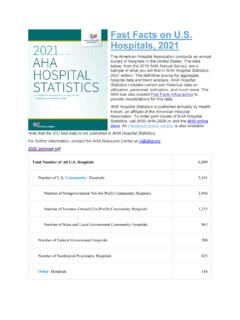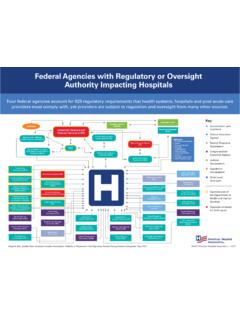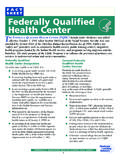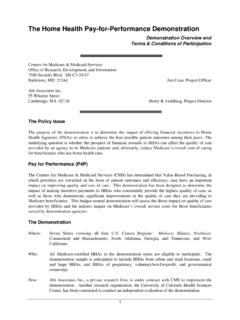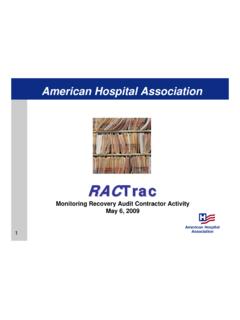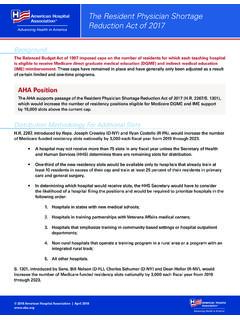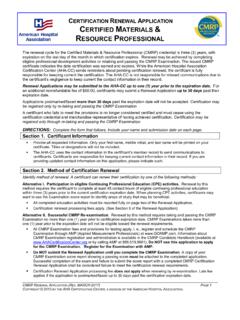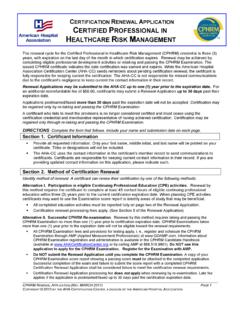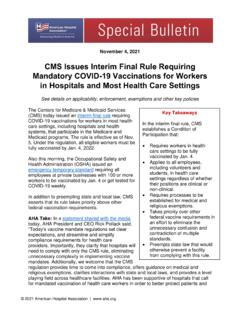Transcription of Engaging Patients and Communities in the Community …
1 E ngaging P atients and C ommunities in the C ommunity H ealth N eeds A ssessment P rocess Engaging Patients and Communities in the CHNA Process 1. A cknowledgments This guide was developed by the Health Research & Educational Trust, with funding from the Patient-Centered Outcomes Research Institute. Suggested Citation: Health Research & Educational Trust. (2016, June). Engaging Patients and Communities in the Community health needs assessment process. Chicago, IL: Health Research & Educational Trust. Accessed at Accessible at: Contact: or (877) 243-0027. 2016 Health Research & Educational Trust. All rights reserved. All materials contained in this publication are available to anyone for download on , or for personal, non-commercial use only. No part of this publication may be reproduced and distributed in any form without permission of the publication or in the case of third-party materials, the owner of that content, except in the case of brief quotations followed by the above suggested citation.
2 To request permission to reproduce any of these materials, please email 2 Engaging Patients and Communities in the CHNA Process T able of C ontents Executive Project Community and Patient Engagement in STEP 1: Identify and engage STEP 2: Define the Community ..13. STEP 3: Collect and analyze STEP 4: Select priority Community health STEP 5: Document and communicate STEP 6: Plan improvement STEP 7: Implement improvement STEP 8: Evaluate Appendix A: American Hospital Association's Review of Final IRS Guidelines for CHNAs ..20. Appendix B: Community Health Needs Assessment Resources ..23. Appendix C: Research Methods and Appendix D: Handout for Patients , Families and Community Appendix E: Using Electronic Health Records for Appendix F: Asset Appendix G: Tools to Engage Community Members and Engaging Patients and Communities in the CHNA Process 3. E xecutive S ummary Nonprofit hospitals across the nation are required to complete Community health needs assessments (CHNAs) every three years.
3 CHNAs involve identifying the health needs of the hospital's Community and creating strategies to address the prioritized needs. Developers of CHNAs are required to engage the Community in this process, for example, by sending out surveys or interviewing key Community stakeholders to identify the most important health concerns. The Health Research & Educational Trust (HRET) of the American Hospital Association (AHA) proposes a new process that involves Engaging Community members and Patients throughout each step of the CHNA process (see Figure 1). By Engaging Patients and Community members throughout the process, CHNA developers obtain valuable insights that otherwise could be missed, get increased Community buy-in, and can develop and implement more effective programs to improve Community health. F igure 1: C ommunity H ealth A ssessment and I mplementation P athway Source: HRET, 2016. 4 Engaging Patients and Communities in the CHNA Process P roject O verview This project is supported through funding by the Patient-Centered Outcomes Research Institute (PCORI).
4 PCORI is an independent, nonprofit organization authorized by Congress in 2010 to fund comparative effectiveness research that will provide Patients , their caregivers and clinicians with the evidence needed to make better-informed health and health care decisions. As part of this project, a diverse range of stakeholders were recruited, including patient and family advocates, applied-communication theorists and those from hospitals and hospital associations. In total, HRET conducted seven focus groups, two panel discussions and 17 interviews, comprising 65 individuals in total. HRET also developed two modules that were pilot tested by representatives from nine hospitals and health systems. Participants provided HRET with robust and insightful ideas regarding patient engagement in CHNAs and Community health improvement plans (CHIPs) and how to better integrate research into the CHNA/CHIP process.
5 Hospitals and health care systems can also make the health improvement strategies of their CHNAs more effective by embedding patient-centered outcomes research (PCOR), and comparative-effectiveness research more broadly, in their processes. Per the PCORI. website, PCOR considers Patients ' needs and preferences and focuses on outcomes most important to them. PCOR findings can help Patients and other health care stakeholders, such as caregivers, clinicians, insurers, policymakers and others, make better-informed decisions about their health and health care options. PCOR can inform the CHNA process by providing evidence-based guidelines for interventions aligned with those identified in CHNAs. Including patient and Community stakeholder perspectives in the research process can better position hospitals to address potential barriers to implementation and lead to strategies to achieve desired health outcomes.
6 Additional information on how CHNA. developers can embed PCOR into the creation of their CHNAs, including relevant PCORI. research findings, can be found in the upcoming HRET guide, Integrating Research into the CHNA Process. Engaging Patients and Communities in the CHNA Process 5. B ackground Community health needs assessments (CHNAs) have the potential to be powerful drivers to enhance the health of Communities . Thousands of hospitals across the United States complete a CHNA process every three years. This process includes reviewing quantitative data on Community health status, soliciting input from Community stakeholders, selecting priority Community health needs and devising strategies to address the identified priority needs. The American Hospital Association's review of the Internal Revenue Service's final rules for CHNAs and implementation strategies can be found in Appendix A. The CHNA process from assessment through implementation and evaluation can catalyze hospitals and their focus on illness prevention and the social determinants of health so they can foster Community wellness and also provide medical services better tailored to their particular populations.
7 Viewing the CHNA as an ongoing improvement process can make hospitals and health systems more Community oriented and help ingrain Community health improvement into the hospital's mission and operations. This approach to health and health care is becoming increasingly central as the health care field moves toward a paradigm focused on population health that financially rewards hospitals for preventing illness. Many resources have been developed over the past decade to support the CHNA process, including approaches to data analytics, county and regional-level health-status data, and evidence-based interventions aligned with CHNA-identified priorities. (Links to relevant resources can be found in Appendix B). With each CHNA cycle, hospitals and health systems are becoming more sophisticated with their approach, and many are going beyond the required elements of the assessment. To elevate the impact of the CHNA both in the hospital and in the Community , hospitals increasingly are recognizing the importance of Engaging Community members and Patients in their processes.
8 C ommunity and P atient E ngagement in CHNA s Hospital Benefits from Engaging Patients and Communities Clearer understanding of the Community that the hospital is part of, including social determinants of health, specific health issues and root causes of those health issues, and the availability of resources to address them. Strengthened bonds between Community and hospital, leading to increased Community collaborations around priority issues. Greater Community buy-in and a sense of shared ownership of and commitment to Community health. Relationships with organizations or individuals who are Community assets; these assets can be leveraged during implementation, which will further Community involvement throughout the CHNA process. Fostering healthier Communities where individuals have access to preventive care and seek care at the appropriate level, potentially leading to lower costs for the hospital.
9 6 Engaging Patients and Communities in the CHNA Process Community and Patient Benefits from CHNA Involvement A different perspective of their Community . Improved communication between Community and hospital, contributing to increased collaboration, mutual respect and understanding. Sense of shared ownership and commitment to the CHNA process, providing impetus and motivation to be invested in the health of the Community and stay involved in the process and any subsequent Community coalitions or collaborative improvement efforts. Ability to apply knowledge and experiences to improve the health of the Community . Feelings of respect, involvement and investment in the success of the CHNA. process and ready to collaborate in the future. C ommunity and P atient E ngagement D efining T erms It is important to establish a common language to use in this report's discussion of the CHNA process. Key terms are defined as follows: Community health needs assessment (CHNA): A systematic process involving the Community to identify and analyze Community health needs and assets, prioritize the needs, and implement a plan to address significant unmet Community health Implementation strategy: The hospital's plan for addressing Community health, including significant health needs identified in the Community member: Any resident of a Community , including an individual at an organization within the Community that hospitals can partner with to address Community health.
10 Patient: An individual who has received any sort of health care . Generally, Patients are a large subset of the Community member group. Some individuals use health care services much more than others and have unique and valuable perspectives on health care and Community health. Engagement: The process by which individuals from the Community or patient population participate in ongoing relationships with individuals from the health care system to benefit their shared Community . When individuals are engaged, they work together to decide which outcomes to pursue and why and how to pursue them. This approach creates a sense of self-efficacy, shared decision making and shared health management for those involved. Making Community and patient engagement a central component of the CHNA process can be mutually beneficial to hospitals and Communities alike. There is not a one-size-fits-all approach to Community and patient engagement; the scope of engagement depends on a variety of hospital and Community factors and preferences.
